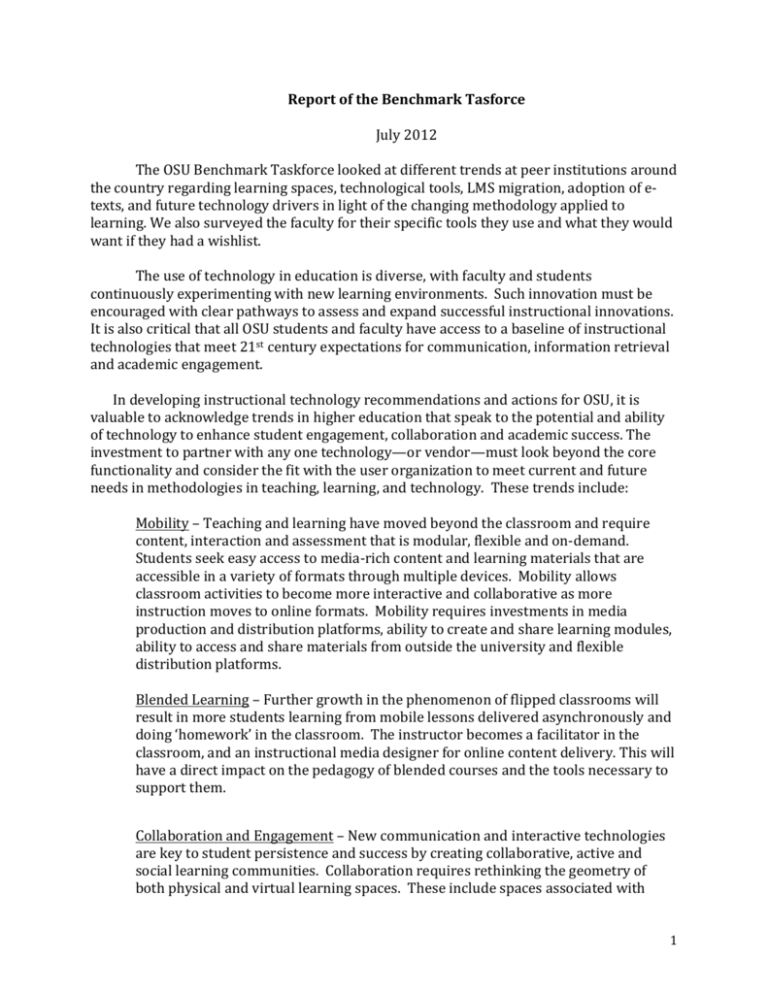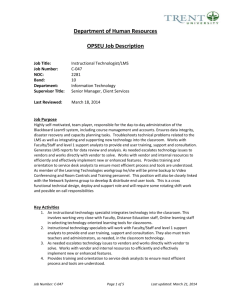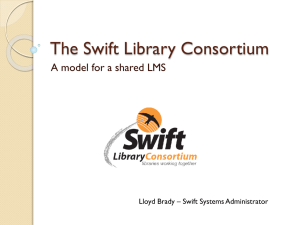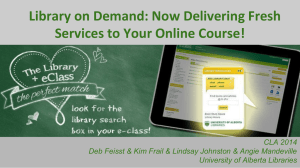Benchmarking Taskforce Report
advertisement

Report of the Benchmark Tasforce July 2012 The OSU Benchmark Taskforce looked at different trends at peer institutions around the country regarding learning spaces, technological tools, LMS migration, adoption of e-­‐ texts, and future technology drivers in light of the changing methodology applied to learning. We also surveyed the faculty for their specific tools they use and what they would want if they had a wishlist. The use of technology in education is diverse, with faculty and students continuously experimenting with new learning environments. Such innovation must be encouraged with clear pathways to assess and expand successful instructional innovations. It is also critical that all OSU students and faculty have access to a baseline of instructional technologies that meet 21st century expectations for communication, information retrieval and academic engagement. In developing instructional technology recommendations and actions for OSU, it is valuable to acknowledge trends in higher education that speak to the potential and ability of technology to enhance student engagement, collaboration and academic success. The investment to partner with any one technology—or vendor—must look beyond the core functionality and consider the fit with the user organization to meet current and future needs in methodologies in teaching, learning, and technology. These trends include: Mobility – Teaching and learning have moved beyond the classroom and require content, interaction and assessment that is modular, flexible and on-­‐demand. Students seek easy access to media-­‐rich content and learning materials that are accessible in a variety of formats through multiple devices. Mobility allows classroom activities to become more interactive and collaborative as more instruction moves to online formats. Mobility requires investments in media production and distribution platforms, ability to create and share learning modules, ability to access and share materials from outside the university and flexible distribution platforms. Blended Learning – Further growth in the phenomenon of flipped classrooms will result in more students learning from mobile lessons delivered asynchronously and doing ‘homework’ in the classroom. The instructor becomes a facilitator in the classroom, and an instructional media designer for online content delivery. This will have a direct impact on the pedagogy of blended courses and the tools necessary to support them. Collaboration and Engagement – New communication and interactive technologies are key to student persistence and success by creating collaborative, active and social learning communities. Collaboration requires rethinking the geometry of both physical and virtual learning spaces. These include spaces associated with 1 classrooms and computer labs and expanding communication tools that link OSU with the world and advances interaction among students, between students and faculty and between students and instructional materials. There is a cultural shift from individual learning to social learning and authentic assessment. Linear lock step is out. Nonlinear, interactive is in. Technocratic, developer-­‐king rule is out. Learner-­‐driven democracy is in. Integrated (and Flexible) Learning Systems – The traditional LMS evolved from and still clings to a faculty-­‐centric perspective. However, the new order is student-­‐ centric, moving away from teaching and toward learning. To meet this new normal, learning systems are becoming more integrated and holistic. Stand alone teaching and learning technologies are giving way to sub(?)systems that are modular and can be integrated into systems that manage content, facilitate communications, deliver media, support assessment and provide user support. These systems provide flexible learning environments and support teaching and learning across the curriculum, in the classroom and online. They will be increasingly used to create persistent products that can be easily repurposed, parsed and shared in a variety of learning environments, from full-­‐blown courses to single-­‐objective learning objects. Readiness for New Metrics of Learning. – The quest for degree-­‐based learning and credits is shifting to the desire for lifelong learning, learning outcome assessment, and mastery certification. There is a subsequent movement away from final exams and the grade culture and movement towards learning outcomes. New demands and new audiences will necessarily move us away from the LMS as walled garden. and toward open access. Demand for more use of video will necessitate increases in both video origination (1-­‐to-­‐many) and video brokering (many-­‐to-­‐many) technologies. We will see an increased demand for tools to facilitate learner created media. Demand for speed and efficiency will only increase. LMS content is single-­‐purpose, and ends when a course is complete. The trend is to move to products with better support for multi-­‐ institutional adoption. Training and support – Investments in instructional technology are fully realized only with adequate faculty and student training and support. To ensure IT investments improve instruction and learning, excellent training and support services must be in place. The training and support services must include technical expertise, best practices, assessment and feedback loops to advise future investments. Faculty support systems should utilize and demonstrate mobility, collaboration and be system-­‐focused. Learning Spaces Classrooms will remain a core teaching and learning arena for the campus. However, classroom capacity will not keep pace with projected enrollments and 2 active learning environments are changing how classroom space is designed and utilized. With a new classroom building scheduled in the next 5 years and funds set aside for classroom remodels, it is imperative that the campus design spaces that facilitate learner collaboration, and, engagement, and activities associated with the “flipped” classroom. See appendix for specifics on classroom standards. Instructional technologies/presentation ware All classrooms will have Internet access, presentation ware and collaboration tools appropriate to the room size and teaching methods employed. Collaboration tools can include: electronic white boards, clickers, videoconferencing, collaborative writing and media production tools, etc. Collaborative Student Study Areas All new and remodel space must include and plan for collaborative work spaces and a review of existing building space should be undertaken in increase areas for students to work collaborative. Collaborative work space will include tables, chairs, wireless internet, electrical outlets, electronic white boards…. Such space should be integrated with classrooms, labs, and student support areas. Academic Content Providers Microsoft and Barnes and Noble (April 2012) formed a subsidiary for e-­‐books and college textbooks. They see the e-­‐textbook market pretty much doubling in the next few years. Faculty and administrators think E-­‐content has a big advantage in being suited for adaptive learning tools and for real-­‐time assessment, but are concerned about loss of critical thinking when textbook use declines. Student preference drives decisions about content type and delivery modes. More modular/granular delivered content rather than full course texts. Big publishers will continue to develop more modularized content. This means lecture+multimedia+interactive+assessment on individual topics. Topics will be smaller than a textbook chapter. Full sets are already available from some publishers, instructors can pick and choose. There are also new models of what an e-­‐text could be – more interactive, modular and containing ways for instructors to assess students, another example of that trend is Nature’s Principles of Biology http://www.nature.com/nature_education/interactive_textbooks Faculty are using Open Access (free and publicly available) materials to create online course packets that students would not have to pay for. The Alternative Textbook project at Temple University is an example of this. http://sites.temple.edu/alttextbook/ Publishers are moving away from holding faculty focus groups and prefer holding student focus groups. Students want multimedia and different and cutting-­‐edge 3 delivery choices. Faculty don’t care as much as students, and will not drive this decision. Publishers want to improve and use more adaptive learning technology, both to improve student experience and to improve assessment data. Summary The task force findings support the observation that technology and our understanding of learning are ahead of current academic practice. This is true within the LMS as well, whose design perspectives support the status quo, while the new order is future facing. The future of the LMS can be summarized in four points (http://campustechnology.com/0711_brown): 1. The most important issue facing the LMS is its relevance to the kinds of initiative-­‐ based and authentic learning that it will be used to support. 2. For the LMS to be useful in the new world of personal learning environments and e-­‐ portfolios, it will have to be so seamlessly integrated into the World Wide Web that it will be difficult to recognize. 3. Facebook has taught us that learning is fundamentally and irrepressibly social in nature. 4. Educators must evolve, not as sages or guides, but as agents responsible for educational strategy, activity, and assessment design. Those who prevail will become mediators for learners brave enough to face today's many pressing and all-­‐ too-­‐authentic challenges. APPENDIX 1: Survey (complete survey is attached) This taskforce joined with the taskforce chaired by Cary Green to survey faculty about their use of different learning-­‐related tools they use to help their students learn. We used open-­‐ended questions that allowed for different responses and also asked a couple of questions specific to a “wishlist” for LMS features to attempt to find out what they thought was missing. An overview of the results of the survey follow: What teaching and learning-­‐related tools do you use in your class and how do you use them to help your students learn? There were different uses listed for some of the technologies that faculty employed in the classroom. Some used audience response systems for attendance tracking as part of the grading criteria while others used them to gauge student understanding of the material being presented and for in class quizzes. Blackboard is being used in the on campus class room in many different ways ranging from just a place to post a syllabus and handouts to an integral part of the instruction where student interact with each other and with course materials outside of the classroom. 4 Social media is also being integrated – everything from a class Facebook page to students creating Wikis as group projects and Blogs to share thoughts and writings. The most used classroom tools are the document reader, smartboards and projectors. Several responses noted that they use tools outside of Bb that do that same thing as Bb tools, but are easier to use (blogs, wikis, discussions). Also, various other web tools such as Zotero, Google docs, skype, and library tools were mentioned. Also of note were responses that were non-­‐technology related such as group work, discussions and personal interaction. There were several responses that stated that the chalk board was the best technology and that the old fashioned way of students taking notes from an instructor writing on the chalk board was the best way for students to study math. One response said it would be great if they had access to good quality blackboards (NOT whiteboards) that covered multiple walls. What are the most important issues or challenges you face in using an LMS? Most of the comments in reply to this question were describing technical glitches, slowness, clunkiness, and outdated features of Bb. Many also said it’s more hassle than it’s worth to do the many clicks required for a single action. It was pointed out that students will not use Blackboard after graduation and they should be using something that will be useful to them later such as Google Docs, Dropbox, other online tools. What are some of the teaching and learning tools you would like to see available? Most answers to this questions were the same: Adaptive learning tools, analytics, mindmapping software, the ability to share video easily, voice tools in Blackboard, interactive features that are synchronous, social networking tools, Apple learning tools. What features and functions would you like to see in an LMS five years from now? Flexibility was answer that stood out along with the ability to collaborate online in an easier way, such as for a group project, in a kind of wiki environment where they put something together jointly. Real time face-­‐to-­‐face communication/interaction for individuals and large groups regardless of physical location APPENDIX 2: Peer Institutions and LMS North Carolina State University (31,000 students) has decided to move from Vista to Moodle in 2011. University of Minnesota (51,721 students) is moving from Vista to Moodle in 2012. University of North Carolina Chapel Hill (28.916 students) is moving from Blackboard to Sakai in 2014. Michigan State University Currently using ANGEL -­‐ moving but not sure where – Moodle possibly. Cornell University -­‐ Blackboard 9.1 5 The Ohio State University -­‐ Carmen Pennsylvania State University Feldstein says: “The 14 schools in the Pennsylvania State System of Higher Education, or PASSHE (119,513 students) were on a mix of Blackboard, WebCT, and eCollege—but mostly Blackboard—and they recently switched to Desire2Learn.” Purdue University -­‐ Blackboard Learn. In the process of moving from Blackboard Vista Texas A & M University -­‐ Blackboard Vista (formerly used WebCT) University of Arizona -­‐ Desire2Learn. University of Illinois -­‐ WebCT and Blackboard The second generation of Illinois Compass made its debut on the Illinois campus in November 2011. CITES will offer both the original Illinois Compass software (powered by Blackboard Vista) and Illinois Compass 2g (powered by Blackboard Learn 9.1) for Spring, Summer, and Fall 2012 semesters, giving instructors time to choose when to move their courses to the new system over the next year University of Wisconsin -­‐ Desire2Learn is supported system-­‐wide, but UW has been looking at alternatives. http://www.wisconsin.edu/olit/luwexec/projects/exploratorytask/ LMS Exploratory Task Force Report http://www.wisconsin.edu/olit/luwexec/projects/exploratorytask/finalreport.pdf Faculty Staff Survey of Online Teaching, Learning and Support, 2010 https://learnuw.wisconsin.edu/survey/Report%20on%202010%20Faculty%20Survey%2 0-­‐%20FINAL.pdf APPENDIX 3: Highlights of research on LMS trends and future expectations: MIT plans for LMS (http://web.mit.edu/fnl/volume/242/hastings_abelson.html) In 2009, the MIT Council on Educational Technology charged the Faculty Committee on Learning Management Systems (LMS) to provide strategic guidance on the future of LMS at MIT. MIT needed a more robust LMS with the flexibility and features necessary to support the evolving pedagogical and technological innovations in the classroom. In moving forward, MIT shifted resources to the development of the Modular Service Framework as the new foundation for learning management at MIT. This approach offers a set of discrete, flexible Web services driven by a common data framework and based on a standardized set of Application Programming Interfaces (APIs). With a focus on flexibility and integration, the Modular Service Framework is well positioned to meet MIT’s future LMS needs, including the technological evolution mandated by Digital MIT, as well as the emerging trends in curriculum development and online education. In this model, key functional components are represented by individual Web services that can be utilized as either standalone modules or as part of an integrated set of user tools. These Web services are driven by common core data sets, and share common standardized APIs. This aspect of the model eases integration and interoperability with community-­‐developed and third party tools. Such an approach encourages community innovation while balancing individual customizability and extensibility with service standardization and the reduction of support overhead. 6 APPENDIX 4 – Classroom standard recommendations Classroom standards -­‐ Large Lecture Halls -­‐ 300+. Fixed seating with an extra aisles for circulation, multiple projection, clickers, presentation capture and other enhancements that allow for flexible pedagogy in large classes. -­‐ Large Classrooms -­‐ 130-­‐300. Seating that provides circulation and group work (rotating seats) so even a large class can feel like a community of learners, including dual (or triple) projection, clickers, and presentation capture. -­‐ Medium Classrooms – Mixture of the following: o 70-­‐130 seats: “lecture” seating like the 300+ seat rooms to accommodate enrollment growth and provide some level of learning community. o Medium SCALE-­‐UP Room 50 -­‐ 70 seats: SCALE-­‐UP style classroom where true interactivity and community are built into a classroom -­‐ these classrooms have round tables that seat 9 per table, and no 'front' -­‐ this is truly student-­‐centered learning. -­‐ Small Classroom -­‐ 35-­‐70 seats: movable seating that can be reconfigured from lecture to group work, to function between the modes of student centered and instructor centered as needed – presentation and group technology. -­‐ Small group rooms -­‐ > 35 seats: moveable seats and to provide flexibility for different types of activities and student centered technology. Dianna Fisher, Ecampus John Greydanus, Information Services Michael Lerner, College of Science (Chemistry) Margaret Mellinger, Library Jeff Hino (EESC) Robin Pappas, CTL Malcolm LeMay, College of Business 7



